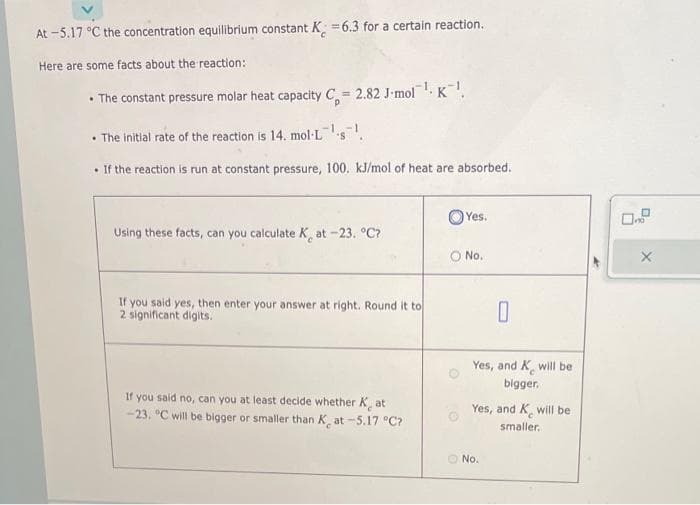At -5.17 °C the concentration equilibrium constant K = 6.3 for a certain reaction. Here are some facts about the reaction: • The constant pressure molar heat capacity C Р 2.82 J-mol¹ K -1 • The initial rate of the reaction is 14. mol-L¹s¯¹. . If the reaction is run at constant pressure, 100. kJ/mol of heat are absorbed. Using these facts, can you calculate Kat-23. °C? If you said yes, then enter your answer at right. Round it to 2 significant digits. If you said no, can you at least decide whether Kat -23. °C will be bigger or smaller than K, at-5.17 °C? Yes. O No. 0 Yes, and K will be bigger. Yes, and K will be smaller. No. □
At -5.17 °C the concentration equilibrium constant K = 6.3 for a certain reaction. Here are some facts about the reaction: • The constant pressure molar heat capacity C Р 2.82 J-mol¹ K -1 • The initial rate of the reaction is 14. mol-L¹s¯¹. . If the reaction is run at constant pressure, 100. kJ/mol of heat are absorbed. Using these facts, can you calculate Kat-23. °C? If you said yes, then enter your answer at right. Round it to 2 significant digits. If you said no, can you at least decide whether Kat -23. °C will be bigger or smaller than K, at-5.17 °C? Yes. O No. 0 Yes, and K will be bigger. Yes, and K will be smaller. No. □
Chemistry
10th Edition
ISBN:9781305957404
Author:Steven S. Zumdahl, Susan A. Zumdahl, Donald J. DeCoste
Publisher:Steven S. Zumdahl, Susan A. Zumdahl, Donald J. DeCoste
Chapter17: Spontaneity, Entropy, And Free Energy
Section: Chapter Questions
Problem 120CP: The equilibrium constant for a certain reaction decreases from 8.84 to 3.25 102 when the...
Related questions
Question

Transcribed Image Text:At -5.17 °C the concentration equilibrium constant K = 6.3 for a certain reaction.
Here are some facts about the reaction:
• The constant pressure molar heat capacity C = 2.82 J-mol K.
• The initial rate of the reaction is 14. mol-L¹s¹.
.
If the reaction is run at constant pressure, 100. kJ/mol of heat are absorbed.
Using these facts, can you calculate Kat-23. °C?
If you said yes, then enter your answer at right. Round it to
2 significant digits.
If you said no, can you at least decide whether Kat
-23. °C will be bigger or smaller than Kat-5.17 °C?
Yes.
No.
0
Yes, and K will be
bigger.
Yes, and K will be
smaller.
No.
X
Expert Solution
This question has been solved!
Explore an expertly crafted, step-by-step solution for a thorough understanding of key concepts.
Step by step
Solved in 4 steps with 2 images

Knowledge Booster
Learn more about
Need a deep-dive on the concept behind this application? Look no further. Learn more about this topic, chemistry and related others by exploring similar questions and additional content below.Recommended textbooks for you

Chemistry
Chemistry
ISBN:
9781305957404
Author:
Steven S. Zumdahl, Susan A. Zumdahl, Donald J. DeCoste
Publisher:
Cengage Learning


Chemistry: An Atoms First Approach
Chemistry
ISBN:
9781305079243
Author:
Steven S. Zumdahl, Susan A. Zumdahl
Publisher:
Cengage Learning

Chemistry
Chemistry
ISBN:
9781305957404
Author:
Steven S. Zumdahl, Susan A. Zumdahl, Donald J. DeCoste
Publisher:
Cengage Learning


Chemistry: An Atoms First Approach
Chemistry
ISBN:
9781305079243
Author:
Steven S. Zumdahl, Susan A. Zumdahl
Publisher:
Cengage Learning

Chemistry: The Molecular Science
Chemistry
ISBN:
9781285199047
Author:
John W. Moore, Conrad L. Stanitski
Publisher:
Cengage Learning

Principles of Modern Chemistry
Chemistry
ISBN:
9781305079113
Author:
David W. Oxtoby, H. Pat Gillis, Laurie J. Butler
Publisher:
Cengage Learning

Chemistry & Chemical Reactivity
Chemistry
ISBN:
9781337399074
Author:
John C. Kotz, Paul M. Treichel, John Townsend, David Treichel
Publisher:
Cengage Learning